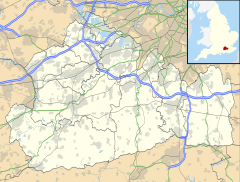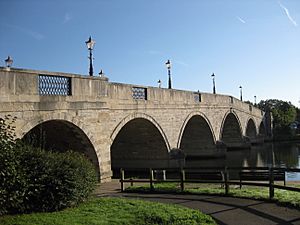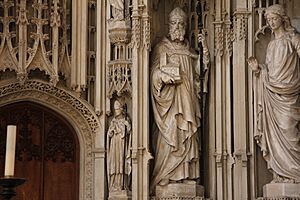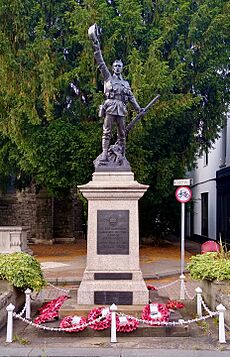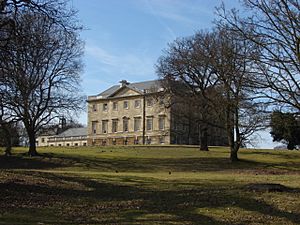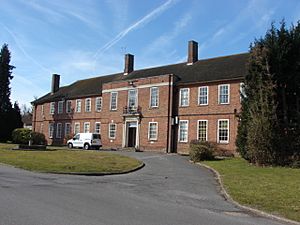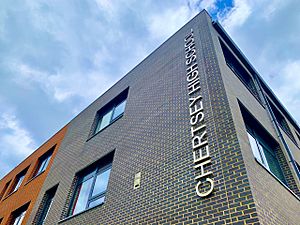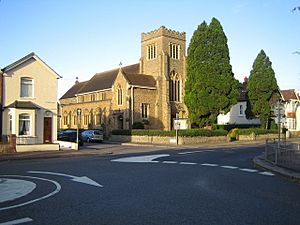Chertsey facts for kids
Quick facts for kids Chertsey |
|
|---|---|
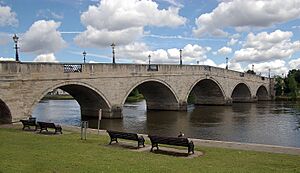 Chertsey Bridge |
|
Guildford Street The principal Shopping Street with an adjoining arcade and supermarket. |
|
| Population | 15,967 |
| OS grid reference | TQ039667 |
| District |
|
| Shire county | |
| Region | |
| Country | England |
| Sovereign state | United Kingdom |
| Post town | Chertsey |
| Postcode district | KT16 |
| Dialling code | 01932 |
| Police | Surrey |
| Fire | Surrey |
| Ambulance | South East Coast |
| EU Parliament | South East England |
| UK Parliament |
|
Chertsey is a town in Surrey, England. It is about 18 miles (29 km) southwest of central London. The town grew around Chertsey Abbey, which was founded in 666 AD by St Erkenwald. Chertsey was given permission to hold a market by King Henry I. A bridge across the River Thames was first built here in the early 1400s.
The River Bourne flows through the town and joins the River Thames near Weybridge. Chertsey has an old church with parts from the Middle Ages. Many buildings from the 1700s are still standing, like the stone Chertsey Bridge and Botleys Mansion. A special bell, called the curfew bell, rings at 8 PM on weekdays during autumn and winter. This bell is part of a local legend about a brave woman named Blanche Heriot. You can see a statue of her and the bell near Chertsey Bridge.
Chertsey has nice green spaces. These include the Thames Path National Trail, Chertsey Meads, and a small hill called St Ann's Hill. On St Ann's Hill, you can find the remains of an ancient hill fort called Eldebury Hill.
Trains run from Chertsey railway station to London Waterloo. The town is also close to the M25 motorway, which is a big road that goes around London. Chertsey has a population of about 16,000 people.
Contents
- What's in a Name? The Meaning of Chertsey
- A Look Back: Chertsey's History
- Chertsey's Location and Landscape
- What Chertsey is Known For: Economy
- Famous Places in Chertsey
- Sports and Fun in Chertsey
- Schools in Chertsey
- How Chertsey is Governed
- Places of Worship
- Getting Around: Transport in Chertsey
- Famous People from Chertsey
- Images for kids
- See also
What's in a Name? The Meaning of Chertsey
The name Chertsey has a long history! The first time it was written down was around 750 AD by a historian named Bede. He called it Cerotaesei, which means "the island of Cerotus".
Later, in old documents from the 600s, it was spelled Cirotesige or Cerotesge. In the Domesday Book from 1086, it was called Certesi. The modern spelling "Chertsey" first appeared in 1559.
The first part of the name, "Chert", likely comes from an old Celtic person's name, Cerotus. The second part, "sey", comes from an Old English word meaning "island" or "land with lots of water".
A Look Back: Chertsey's History
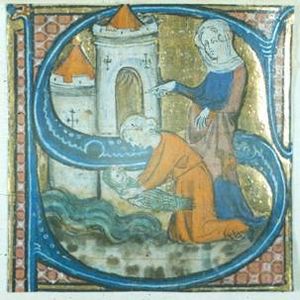
Chertsey is one of England's oldest market towns. Its main church dates back to the 1100s. The town grew around Chertsey Abbey, which was founded in 666 AD by Erkenwald, the Bishop of London.
In the 800s, Danes attacked and damaged the abbey and town. Later, in 964, King Edgar helped rebuild the abbey.
The Domesday Book of 1086 mentions Chertsey. It shows that the town had five farms, a mill, and a forge. It also had lots of farmland and woodland.
The abbey became one of the largest Benedictine abbeys in England. But in 1536, Henry VIII closed it down. The King even used stones from the abbey to build his palace at Oatlands Palace. Today, only some outer walls of the abbey remain. You can still see the abbey's old fishponds, which fill with water after heavy rain.
The Chertsey Bridge, built in the 1700s, is an important crossing over the river. Near the bridge, there's a bronze statue of Blanche Heriot, a local hero.
In the 1700s, the Chertsey Cricket Club was very strong. In 1789, the Duke of Dorset, who played for Chertsey, tried to take the team to France to teach cricket to the French. But the French Revolution started, and the trip was cancelled!
The first Chertsey railway station opened in 1848. The current station opened in 1866. The train line became electric in 1937.
In the 1800s, Chertsey was known for making malt, flour, and bricks. It also had a bell foundry and an iron foundry.
Chertsey's Location and Landscape
Chertsey is part of the London commuter belt, meaning many people who live here travel to London for work. It's about 18 miles (29 km) from London. Green areas called "Green Belt" separate Chertsey from nearby towns.
The town centre is a special "conservation area" because of its historic buildings. Many of these buildings, including shops and houses, date back to the 1500s and 1600s.
Chertsey is generally low-lying, about 14 metres above sea level in the town centre. The lowest point is 11 metres at Chertsey Bridge. The highest point is St Ann's Hill, which is 77 metres high.
The town centre is on a flat area near the River Thames and The Bourne. The ground here is made of river gravels and sandy soil. St Ann's Hill is different, made of older rock layers.
What Chertsey is Known For: Economy
Besides being a place where people live and travel to London for work, Chertsey is home to some big companies. Compass Group has its main office here. Samsung Electronics also has its UK and European headquarters in Chertsey. Samsung moved here in 2005.
Thorpe Park, a popular theme park, is right on the edge of Chertsey. You can easily get there by bus from Chertsey and Staines-upon-Thames.
Famous Places in Chertsey
Chertsey Bridge: A Historic Crossing
Chertsey Bridge is a very old and important bridge. It's a Scheduled Ancient Monument and a Grade II* listed building, which means it's protected for its historical value. It was built between 1783 and 1785 by James Paine. The bridge is made of light stone and has seven arches. It cost £13,000 to build, which was a huge amount of money back then!
Chertsey Museum: Step Back in Time
Chertsey has a free museum on Windsor Street. It's a great place to learn about the town's history. The museum has a very important collection of costumes called the Olive Matthews costume collection. It has about three thousand pieces of clothing! The museum also displays clocks made by local clockmakers.
St Peter's Hospital: Caring for the Community
St. Peter's Hospital opened in 1939. It was originally meant to help people injured during World War II. Today, it's a large hospital with 400 beds. It offers many different health services. Hospital Radio Wey has been broadcasting to patients and staff since 1965.
St Peter's Church: An Ancient Building
St Peter's Church has a tower and chancel (the area around the altar) that date back to the 1200s or 1300s. Inside, you can see old paving tiles from the abbey. Some of these tiles are also in the British Museum. The church is surrounded by many other historic buildings in the town centre.
Historic Houses: Curfew House and Pyrcroft House
Curfew House, built in 1725, is a red brick building near the church. Its name comes from the legend of King John and Blanche Heriot. Another important house is 25 Windsor Street, also from the early 1700s.
Pyrcroft House, on Pyrcroft Road, is another historic building. It has a brick front and interesting architectural details.
Botley Park and Bournewood House
Botley Park Mansion is a large building from the 1700s, surrounded by beautiful grounds. It is now a private nursing home. Bournewood House is part of a large hospital complex next to St Peter's Hospital.
Sports and Fun in Chertsey
Football Teams
Chertsey has a local football club called Chertsey Town F.C.. They play at Alwyns Lane. Another club, Dial Square F.C., also shares their ground.
Chertsey Meads: Open Green Space
Chertsey Meads is a large park next to the River Thames. A part of the Thames Path walking trail starts here. The park covers about 170 acres (0.69 km²). There are also camping sites nearby.
Every year in early August, the Chertsey Agricultural Show is held at Chertsey Meads. It's a big event with lots to see and do!
Great Cockcrow Railway: A Miniature Train Ride
Off Hardwick Lane, you can find the Great Cockcrow Railway. This is a miniature railway with trains that run on a 7.25-inch (18.4 cm) wide track. It opened in 1968.
The Black Cherry Fair: A Summer Festival
The Black Cherry Fair is an annual event held on the second Saturday of July. It features live music and refreshments, making it a fun day out for the community.
Schools in Chertsey
Chertsey has several schools for different age groups:
- St Anne's Roman Catholic Primary School
- Salesian Catholic Secondary School (on two sites)
- Pyrcroft Grange Primary School
- Stepgates Community School
- Sir William Perkins's School, an independent girls' school that started in 1725.
- Chertsey High School (opened in 2017)
Chertsey High School
Chertsey High School is a school that welcomes students from all backgrounds. It opened in 2017 in the buildings of the old Meads School. A new school building was built next door and opened in 2019. It can hold up to 900 students. The school has modern facilities, including a 3G sports pitch, which it shares with Abbey Rangers Football Club.
Salesian School
The Salesian School is a Catholic secondary school in Chertsey. It can teach about 1,200 students.
How Chertsey is Governed
Chertsey is part of the Runnymede and Weybridge area for Parliament. The current Member of Parliament (MP) is Ben Spencer.
For local elections, the town is split into two areas: Riverside and West. These areas elect councillors to the Runnymede Borough Council. Chertsey is also represented on the Surrey County Council.
Places of Worship
- St. Anne's Church is a Catholic church on Eastworth Road. St. Anne's School and Salesian School are also Catholic schools in the town.
- St. Peter's is the main Anglican church in the town centre. It holds services on Sundays.
- Beacon Church is a community church located on Guildford Street.
- The International Community Church of Surrey meets at Chertsey Hall.
- Equippers Church meets at The Hub near Chertsey High School.
Getting Around: Transport in Chertsey
Trains
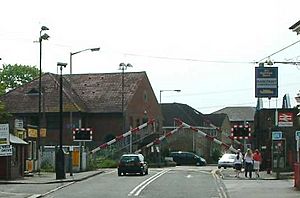
Chertsey station connects to other train lines. You can get to Weybridge railway station in about 11 minutes. A journey to London Waterloo usually takes between 50 and 66 minutes.
Roads
The A320 road goes through Chertsey, connecting Woking to Staines-upon-Thames. Chertsey is about 3 miles (5 km) south of Staines Bridge. The historic Chertsey Bridge connects the town to Shepperton. Chertsey is also very close to Junction 11 of the M25 motorway, which is a major road circling London. It's also near the intersection of the M3 and the M25.
Famous People from Chertsey
Many notable people have connections to Chertsey:
- Richard Steere (1643–1721), a poet and merchant, was born here.
- John Narrien (1782–1860), an astronomer, was born in Chertsey.
- Albert Richard Smith (1816–1860), an author and entertainer, was born here.
- Ethel Mary Boyce (1863–1936), a composer and pianist, was born and lived in Chertsey.
- Charlie Llewellyn (1876–1964), the first non-white South African cricketer, died in Chertsey.
- Keith Moon (1946–1978), the drummer for the Who, lived in Chertsey from 1971 to 1975.
- Mike Rutherford (born 1950), guitarist for Genesis, was born in Chertsey.
- Sir Ian Khama (born 1953), former President of Botswana, was born in Chertsey.
- Vince Clarke (born 1960), keyboardist for Yazoo and Erasure, lived and recorded music here.
- Sean Lock (1963–2021), a comedian, was born in Chertsey.
- Chesney Hawkes (born 1971), a singer, lived in Chertsey.
- Ashley Giles (born 1973), an England cricketer, was born here.
- Robert Green (born 1980), a football goalkeeper, was born in Chertsey.
- Harvey Elliott (born 2003), a Liverpool F.C. football player, was born in Chertsey.
Images for kids
See also
 In Spanish: Chertsey para niños
In Spanish: Chertsey para niños


